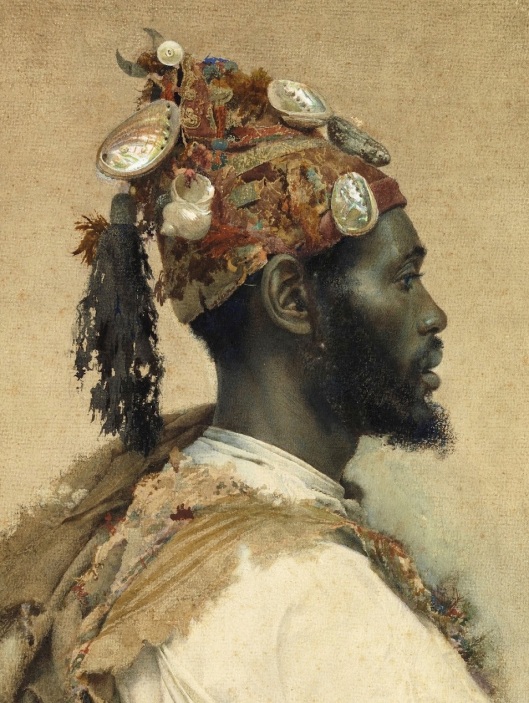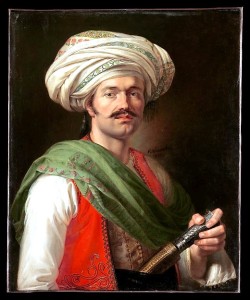Tags
Arts and Crafts Movement, Clichés, Ludwig Deutsch, Orientalism, Théodore Chassériau, Willem de Farmas Testas

The Palace Guard by Ludwig Deutshe (Tumber.com)
I am revisiting my post entitled Orientalism: Good or Bad.
Orientalism and Oriental Studies
My post entitled Orientalism: Good or Bad suggested that one could no longer use the word Orientalism. It had referred to paintings created by Western artists such as Jean-Léon Gérôme and Horace Vernet who painted in a style called academicism, art as it was taught at the Académie des Beaux-Arts in Paris. However, the word Orientalism is still used and Orientalist paintings are sold at auctions and displayed in major museum Claude Piening describes Orientalism as a “genre.”
http://www.sothebys.com/en/news-video/videos/2013/04/orientalist-paintings-sale.html
The link above takes one to publicity (3 minutes) about an auction at Sotheby’s in London. The auction took place in 2013. The word Orientalism was used to describe works by European artists depicting the East. Il was a two-day auction. On the first day, the works of Orientalists were sold. However, on the second day, Sotheby’s auctioned off Islamic art, rather than the paintings of 19th-century Europeans or Western artists featuring the Orient. Wikipedia gives a list of Orientalist Artists. (See List of Orientalist Artists.)
However, one now speaks of Oriental Studies, which includes Egyptology and the work of William Jones (28 September 1746 – 17 April 1794), the philologist who first recognized a relationship between European anguages and Indian languages. (See Indo-European languages, Wikipedia.)
Edward Said’s Orientalism
As for the patronizing Orientalism, studied in Edward Said‘s 1978 controversial Orientalism, it exists. The many depictions of voluptuous white nudes bathing and lounging in harems are examples of Dr Said’s Orientalism. Orientalism may be clichéd and, in this respect, can be associated with colonialism.
The East: Real or Borrowed
Despite its flaws, colonialism, British colonialism in particular, had the benefit of fostering an interest in the Orient, such as William Jones’ research Napoleon lost the Battle of the Nile, but the scholars who accompanied him founded Egyptology. Colonists, mostly British, also discovered objets d’art such as netsuke(s), small Japanese carvings used on belts for men, and cloisonnés, enamel, gems or glass poured into or inserted inside little metal walls called cloisons. They also discovered fine porcelain (now called china) and sumptuous Oriental rugs. These adorned their homes and to this day beautiful rooms often display fine Oriental vases and intricate rugs.
During the 19th century, members of the Arts and Crafts Movement replicated the motifs of the East. Artists and craftsmen associated with the Arts and Crafts movement could create homes decorated to reflect the East, Near or Far, including Japan. Ukiyo-e prints flooded Europe in the second half of the 19th century inaugurating Japonism. Oriental motifs adorned wallpapers, fabric, ceramic or class tiles made in the West. One could also purchase the finest china, made in England and other European countries.
Turquerie, however, was fashionable well before the 19th century. In 1453, Ottoman Sultan Mehmed II conquered Constantinople today’s Istanbul. Eastern Europe fell to the Ottoman Empire. The craze for chinoiserie also preceded the 19th century. As for Orientalism, it dates back to Napoleon’s campaign in Egypt and Syria (1798-1801). (See French Campaign in Egypt and Syria, Wikipedia.)
Orientalist Portraiture
I have focussed on Orientalist portraiture. We have seen Horace Vernet’s portrait of Mameluke Roustam Raza and Gérôme’s portrait of a black Bashi-Basouk. Both portraits are or will be housed in the Metropolitan Museum of Art. Beauty is in the eye of the beholder, but although taste varies, there are objective artistic standards. One may not wish to hang a reproduction of Gérôme’s black Bashi-Basouk in one’s home, but as a work of art, Gérôme’s Bashi-Basouk is an exceptional painting.
Conclusion
Therefore, although a work of art may be clichéd, it may nevertheless be beautiful. The West has depicted the East at times successfully and, at other times, less so. In other words, the art of European painters depicting the East can be good or bad.
I have featured Horace Vernet’s Head of an Arab Man. Today’s choice is Ludwig Deutsh’s Palace Guard.
Love to everyone ♥
Sources and Resources
- Unless otherwise indicated, links are to Wikipedia
- Photo credit: Chassériau, Wikipedia
Deutsch & Willem de Farmas, Pinterest - See List of Orientalist Artists, Wikipedia
- A biography of Roustam Raza’s Memoirs will be available in mid-October.
https://www.amazon.ca/Napoleons-Mameluke-Memoirs-Roustam-Raeza/dp/1936274728 EN - Another edition of his Memoirs is also available. EN
Sections are a Google.book - Les Souvenirs de Roustam, mamelouck de Napoléon 1er are an online. It is a Gutenberg and Archive.org publication [EBook #33534] FR
- It is also a BnF Gallica publication FR

Portrait of a Mameluke, said to be Roustam Raza (ca. 1781–1845) (MMA, NY)
© Micheline Walker
14 September 2016
WordPress






Lovely photos as usual. >
LikeLike
Some Orientalists produced masterpieces and Sotheby’s little video was a gift to me. I see nothing wrong with the pictures I showed. It was a time and a place. Some photographers travel to India where they have found great beauty. Why not. Yes, the photos are lovely. Cheers 🙂
LikeLike
Many thanks. Micheline
LikeLike
There is an opulence of movement and even the male portraits have a strong undercurrent of rampant sensuality. Very riveting. The orient had a very potent sense of celebrating unbridled passion and pleasure. The sun outside and the shaded reclusion of thick walled havens. >
LikeLike
In my opinion, there is considerable beauty to Orientalism. Some paintings may be patronizing and some are mediocre, but how can one generalize and how can one make value judgments. Human beings have a right to express the exotic and the erotic. Ingres'”Grande Odalisque” is a treasure. Ingres never travelled to the Orient. This lady is one he created. Historical painters could paint without looking at a model or borrowed one they transformed. Edward Said was the victim of colonialism. He was Palestinian and lost his country because of an ideology which I hope is disappearing. There was a way of finding room for Jews in the Near East, but the details were for Jews and Palestinians to negotiate. Thank you for writing. Cheers 🙂
LikeLike
I enjoy Albert William Ketèlbey
LikeLike
Gallivanta, that music is lovely, whatever the inspiration. I also like Gilbert and Sullivan’s “The Mikado”. Ketelbey is enjoying a revival, which he deserves. Wishing you well. Micheline 🙂
LikeLiked by 1 person
I did not know Ketelbey is enjoying a revival. My favourite is In A Monastery Garden.
LikeLike
He is enjoying a revival and “A Monastery Garden” seems the favourite work. As you know, there are fashions. I was delighted to find his music combined with good Orientalist artwork. I marvel at what we can find on the internet. It’s extraordinary. Love, Micheline
LikeLiked by 1 person
I agree. I also marvel.
LikeLike
Gallivanta,
What was once the preserve of scholars,the rich, people who lived in large cities has ceased to be is available to every person who has a computer. Even the disabled and people confined to a bed and living in isolated areas can gather information they may enjoy. I truly admire Jimmy Wales and believe he should be nominated for a Nobel Prize. Information from Wikipedia is always perfectly accurate and well presented. Bless him and Google. East and West, North and South, we are all in the conversation. Love Gallivanta. Micheline
LikeLiked by 1 person
Erudite as ever, with an excellent video. Hope you are well, Micheline
LikeLike
Thank you Derrick. There is always something to research and discover. Cheers 🙂
LikeLiked by 1 person